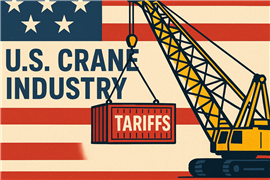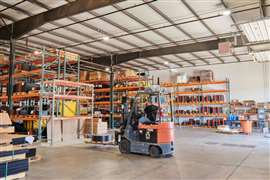Booming bridge
24 April 2008
Daily more than 200,000 commuters battle traffic on the Woodrow Wilson Bridge in the metropolitan Washington, D.C., area. For more than 30 years the bridge has been a traffic nightmare, with residents of Maryland and Virginia suburbs begging for improvements.
At last their pleas were heard, and with a $2.4 billion price tag, the Woodrow Wilson Bridge replacement project commenced in 2000. Today most of the contracts on the project are in the range of 60 to 70% complete, with one span of the replacement bridge complete and open to traffic, remains of portions of the old bridge being removed after implosion in late August, and the second span construction underway both on the Maryland and Virginia sides. The project is scheduled for a 2011 total completion.
Residents of the region were so excited about the partial implosion of the old bridge at midnight on August 28th that a contest was held to identify the commuter with the “worst commute.” The winner, who had traveled the bridge for 28 years, was able to press the plunger which detonated explosives tied to the bridge.
With a project area that spans a seven and a half mile corridor beginning in Maryland and connecting to Virginia, the bridge is at approximately the mid-point of I-95, one of the busiest East Coast interstate highways. The Capital Beltway (I-95 / I-495) connects to the local communities at four interchanges. Replacing the bridge is the centerpiece of the project.
Crane showcase
The new drawbridge will be 20 feet higher than the old bridge with a 70 foot total clearance. The increased clearance will allow for 70% fewer bridge openings and traffic interruptions. Currently, there are nearly 260 openings a year, which will be reduced to approximately 65, as opposed to some 250 times a year in 2003. The two new bridges will have 12 traffic lanes, six each way.
Aside from the massive scope of the project, the most notable aspect has been the number of cranes required on both sides of the river during construction. Not one, two or even three crane rental operations had fleets available to supply cranes needed on the job. It has been estimated that more than 15 crane rental companies have supplied machines, including W.O. Grubb, Buckner HeavyLift, AmQuip, Essex Crane Rental, JF Lomma and many others, and there has been virtually every age, make, model, class and brand of crane on the jobsite at one time or another.
“It's like driving by ConExpo,” says Michelle Grubb, of W.O. Grubb Crane Rental. “Seriously, we have pictures we took at ConExpo that compare to what you see on the jobsite.”
Grubb says crane booms have proliferated in the last few months, as contractors race to dismantle the old bridge and build the new span. “It's like a Who's Who project with all the different crane companies with cranes on the job.”
Boom time
In addition to cranes on barges, there are cranes at either end of the bridges and also on sections of the old bridge that were purposely not destroyed to build the newest span.
Steve Burkholder with Pittsburg, PA-based JF Lomma says his company was putting a Manitowoc 2250 with a Maxer on the job in mid September. The company has had a 100 ton rough terrain crane on the job for several months. The 2250 will be setting pre-cast approaches, he says.
“When you come across the bridge, all you see is booms,” Burkholder says. “It's the most impressive project that you can imagine. And there are some big cranes out there, some 1,000 ton machines. I was so impressed, the first time I went out there I took pictures from my cell phone camera. I do this for a living and it was an impressive to me.”
JF Lomma had been supplying cranes mostly on the Maryland side but will also be placing them on the Virginia side as the contractors have begun to fast track the project, Burkholder explains. In addition, normally competitive crane companies are working together on the project to meet demand. “We're working with Grubb,” he says. “They are going to help us assemble the Max-er.
STAY CONNECTED


Receive the information you need when you need it through our world-leading magazines, newsletters and daily briefings.
CONNECT WITH THE TEAM











